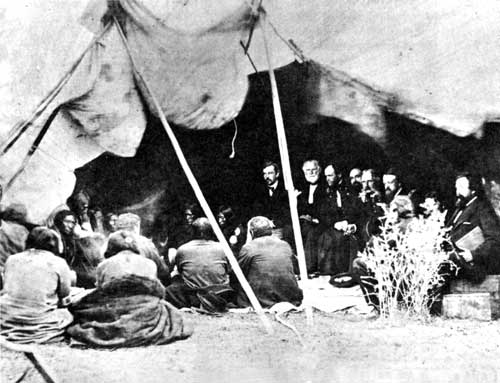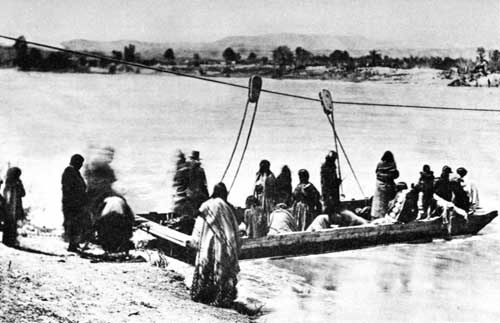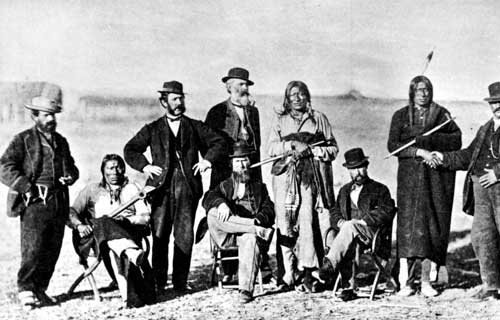|
FORT LARAMIE National Historic Site |
 |

The Peace Commissioners in council with Indians at
Fort Laramie in 1868.
From a photograph by Alexander Gardner in the Newberry
Library.
The Treaty of 1868
Again, the peace advocates in Washington were in the ascendancy, and in the summer of 1867 the Congress provided a commission to treat with the Indians, but authorized recruiting an army of 4,000 men if peace was not attained. Treaties with the southern tribes were concluded at Fort Larned in October, and the commissioners came to Fort Laramie in November to treat with the northern tribes. However, few came in and the hostiles, led by Red Cloud, sent word that no treaty was possible until the forts on the Bozeman Trail and in the valley of the Powder River were abandoned to the Indians. They did agree to cease hostilities and to come to Fort Laramie the next spring. In April 1868, the commissioners came again to Fort Laramie and were prepared to grant the Indians' demands, including abandonment of the Bozeman Trail. By late May, both the Brule and Oglala Sioux had signed the treaty, but Red Cloud refused to sign until the troops had left the Powder River country and his warriors had burned the abandoned Fort Phil Kearny to the ground.

Indians at the North Platte Ferry in 1868.
From a photograph by Alexander Gardner in the Newberry
Library.
This treaty gave the Indians all of what is now South Dakota west of the Missouri River as a reservation. It also gave them control and hunting rights in the great territory north of the North Platte River and east of the Bighorn Mountains as unceded Indian lands. The Indian agencies were to be built on the Missouri River. Many of the Indians, however, objected to giving up trading at Fort Laramie as had been their custom, and, in 1870, a temporary agency for Red Cloud's band was established on the North Platte River 30 miles below the fort, at the present Nebraska-Wyoming line. Finaly, in 1873, after he and other chiefs had twice been taken to Washington and New York to view the numbers and power of the white men, Red Cloud agreed to having his agency moved north to a site on White River away from Fort Laramie and the Platte Road.

Indians and whites at Fort Laramie in 1868.
From a photograph by Alexander Gardner in the Newberry
Library.
In the meantime, peace prevailed on the high plains, and, in 1872, it was reported that not a white man was killed in the department of the Platte.
Later in 1873, however, the attitude of many Indians toward their agents at the Red Cloud and Spotted Tail agencies became so hostile that the agents requested that troops be stationed at the agencies. Although the Indians protested this as a violation of their treaty rights, Camp Robinson and Camp Sheridan were established at these respective agencies in 1874. At the same time, funds were obtained for an iron bridge over the North Platte at Fort Laramie. Its completion, early in 1876, gave the troops there ready access to the Indian country.

Dress parade at Fort Laramie in 1868. Note "Old
Bedlam" at the extreme right.
From a photograph by Alexander Gardner in the Newberry
Library.

|

|
|
Last Modified: Sat, Dec 9 2000 10:00:00 am PDT |


